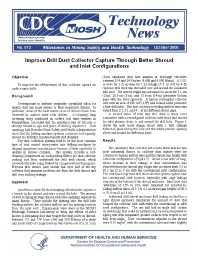Mining Publication: Technology News 512 - Improve Drill Dust Collector Capture Through Better Shroud and Inlet Configurations
Original creation date: October 2005
Overexposure to airborne respirable crystalline silica (or quartz) dust can cause serious or fatal respiratory disease. In particular, some of the most severe cases of silicosis have been observed in surface mine rock drillers. A voluntary lung screening study conducted on surface coal mine workers in Pennsylvania concluded that the incidence rate of silicosis is directly related to age and years of drilling experience. Dust sampling data from the Mine Safety and Health Administration show that the drilling machine operator continues to frequently exceed the federally mandated quartz dust standard. Dry dust collection systems tend to be the most common type of dust control incorporated into drilling machines by original equipment manufacturers because of their capability to operate in various climates. This system includes a self-cleaning (compressed air back pulsing filters) dry dust collector sucking dust from underneath the drill deck shroud, which surrounds the hole being flushed by compressed air (bailing air). Previous drill studies have shown that over half of the dry collector dust emission problems are from the deck shroud and drill stem bushing leakage.
Authors: National Institute for Occupational Safety and Health
Technology News - October 2005
NIOSHTIC2 Number: 20028625
Pittsburgh, PA: U.S. Department of Health and Human Services, Public Health Service, Centers for Disease Control and Prevention, National Institute for Occupational Safety and Health, Technology News 512, 2005 Oct; :1-2
See Also
- Characterization of the 1986 Metal and Nonmetal Mining Workforce
- Improved Drill Shroud Capture of Respirable Dust Utilizing Air Nozzles Underneath the Drill Deck
- Possible Impact of New Safety Technology Developments on the Future of the United States Mining Industry
- Reducing Low Back Pain and Disability in Mining
- Reducing Respirable Dust Exposure of Workers Using an Improved Clothes Cleaning Process
- Selected Health Issues in Mining
- Technique to Assess Hazards in Underground Stone Mines: the Roof Fall Risk Index (RFRI)
- Technology News 447 - Dust Collector Discharge Shroud Reduces Dust Exposure to Drill Operators at Surface Coal Mines
- Technology News 509 - A New Method to Clean Dust From Soiled Work Clothes
- Underground Mine Communications
- Content source: National Institute for Occupational Safety and Health, Mining Program


 ShareCompartir
ShareCompartir
